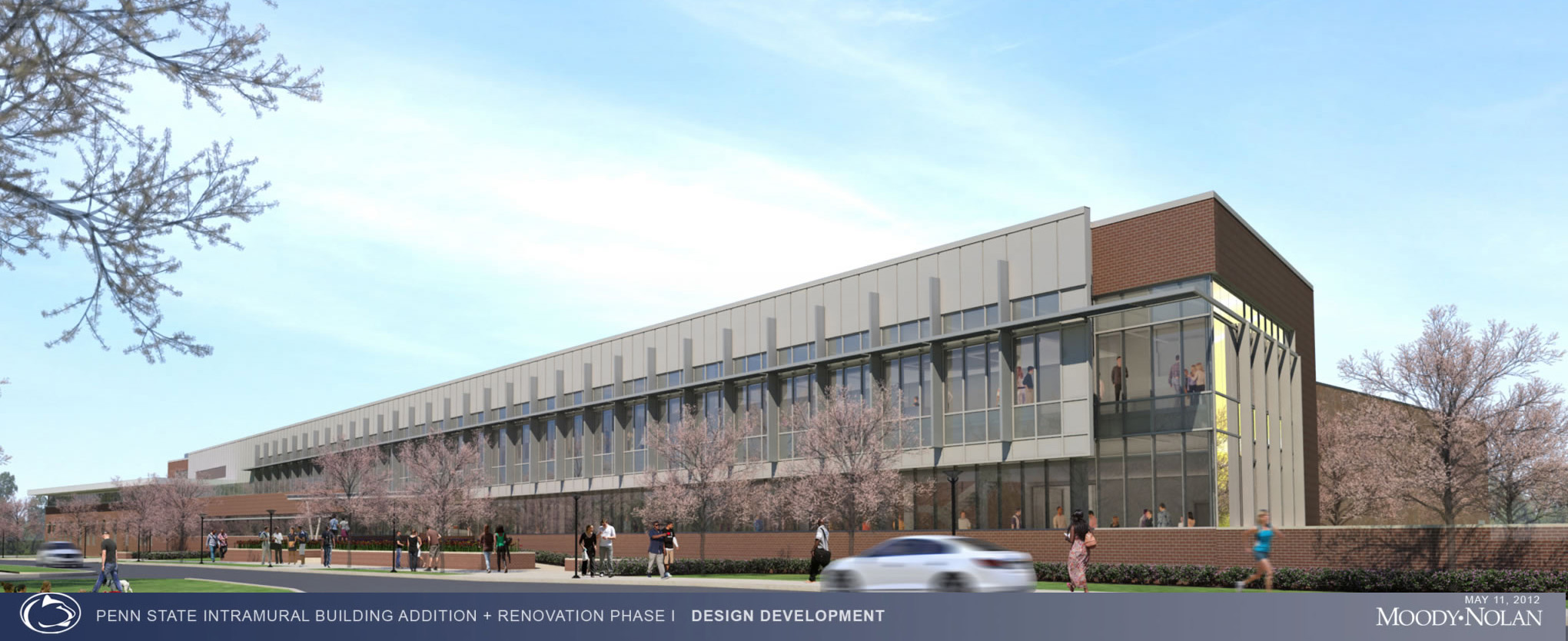The purpose of the Proposal is to identify key research areas which correspond to the construction and design of the Intramural Building Addition and Renovation Project at University Park, PA. The themes of the proposal emphasize on the reduction of construction costs, acceleration of the schedule during the construction phase, and the opportunity of lowering design and construction discrepancies by the use of a more integrated and collaborative delivery method. |
| |
| Revised Breadths - Feb 3rd, 2014 |
| Structural Breadth |
Linked to analysis 1 and 2, the structural frame of the building will be under a new exterior loading. The potential of reducing the sizes of both columns and beams for the exterior members would require structural calculations. Column redesign and composite beam calculations will be performed to analyze the feasibility of this proposal. |
| Mechanical Breadth |
In analysis 1, it was proposed to prefabricate brick veneer system which could potentially accelerate the schedule and reduce construction labor costs. An investigation of prefabricated brick panels comprised of different components to the existing system will be conducted to meet or exceed performance required by the building (energy loads and R-values). A study of energy use will be done with existing and proposed design to demonstrate the change on the mechanical system. |
| |
| |
| Analysis 1 | Prefabricating Building Enclosure |
| The Intramural Building new addition’s enclosure consists primarily of brick veneer façade and curtain wall glazing. Covering large percentages of the building enclosure, the opportunity of utilizing prefabricated panels or modular façade systems would potentially accelerate the schedule and reduce labor costs. By eliminating the use of traditional methods to enclose the building the construction site would be less congested, offer higher quality and performance products and help move quickly on the critical path. Structural and architectural breadths will be performed to evaluate the feasibility, aesthetics and performance of implementing these systems. |
| |
| Analysis 2 | Alternate Delivery Method |
| Discrepancies between the design team and subcontractors led to schedule delays in the project’s building structural system and enclosure. The problem to identify is why this particular delivery method was utilized and if there are other, more integrated and collaborative methods to design and construct a building. An investigation into the delivery method used on the project will be conducted in order to determine the benefits of having a more collaborative and integrated project team. |
| |
| Analysis 3 | Prefabrication Structural Effects |
| Linked to analysis one by the prefabrication of panels, this analysis will focus on a feasibility study of the impacts of the new structural loading. Because prefabricated brick panels usually weigh less than traditional brick systems, the loading on the exterior beams and columns would change, potentially reducing the sizing of these members. This would lead to lower material costs and provide savings. Additionally, how the panels will be connected to the structural system would be analyzed. |
| |
| Analysis 4 | Phased vs. Empty Construction |
| The project is scheduled to be fully operational during the construction of the new addition and renovation. During the project, unexpected events can lead to delays which could potentially disrupt the comfort of the occupants. Therefore, there are certain commitments which must be accepted by the occupants before the construction starts. This analysis focuses on how to make those decisions. |
| |
| Breadth Topics |
| Structural Breadth | Technical Analysis 1 and 3 |
The structural system of the Intramural Building is oddly shaped and contains complex connections. Since connections were designed to be welded, bolted and both; an evaluation and alteration of design will be performed to minimize the amount of welds on site in hopes of reducing the costs of the labor and durations associated with the inspections and placement of welds. The redesign of these structural connections might need additional members to have the same structural performance, and also need to be specially fabricated. It might also require the resizing of structural members such as columns, beams and girders to a lighter frame. Even though these might raise the costs of steel fabrication, the on-site labor costs have the potential to be reduced, as well as the installation times. A couple of bays are going to be analyzed and redesigned to demonstrate the possibility of having only bolted connections. A thorough investigation on a couple of typical bays with connections of the building can be performed to identify where it would be beneficial to minimize welded connections or implement more bolted connections in regards to provide structural support. The costs (schedule reduction, labor rates for installation and fabrication, material prices, production costs) of implementing the new structural connection designs will be presented in matrix form, comparing the proposed and existing designs. |
| |
| Architectural Breadth | Technical Analysis 1 |
The architectural breadth will be directly associated with the building enclosure. The areas of benefit for the prefabricated brick panels is along the West and South-West portions of the building which contains 20 feet high wall sections divided by windows which are not evenly spaced. Proposed change for the brick portion is to evenly space the windows to allow for prefabrication of same size panels to be shipped and erected on site. Architectural concepts will be analyzed which affect the building occupants, such as brick patterns, color, material, and mechanical properties (R-value, moisture barriers, water penetration, etc.). In addition, the incorporation of a modular curtain wall system will provide the opportunity to research modular systems which are operational and easier to install than stick built systems. Lighting and mechanical concepts will be analyzed with the implementation of this design, such as lighting effects, heat gain/loss, and penetrations. It is also very crucial to prevent major changes to the façade, while keeping the owner pleased with not only the performance, but also the aesthetic view of the building. Window spacing and panel sizing will be considered to have minimal floor plan and elevation changes. Architectural sections, views and details will be included to illustrate and compare the proposed system. |



